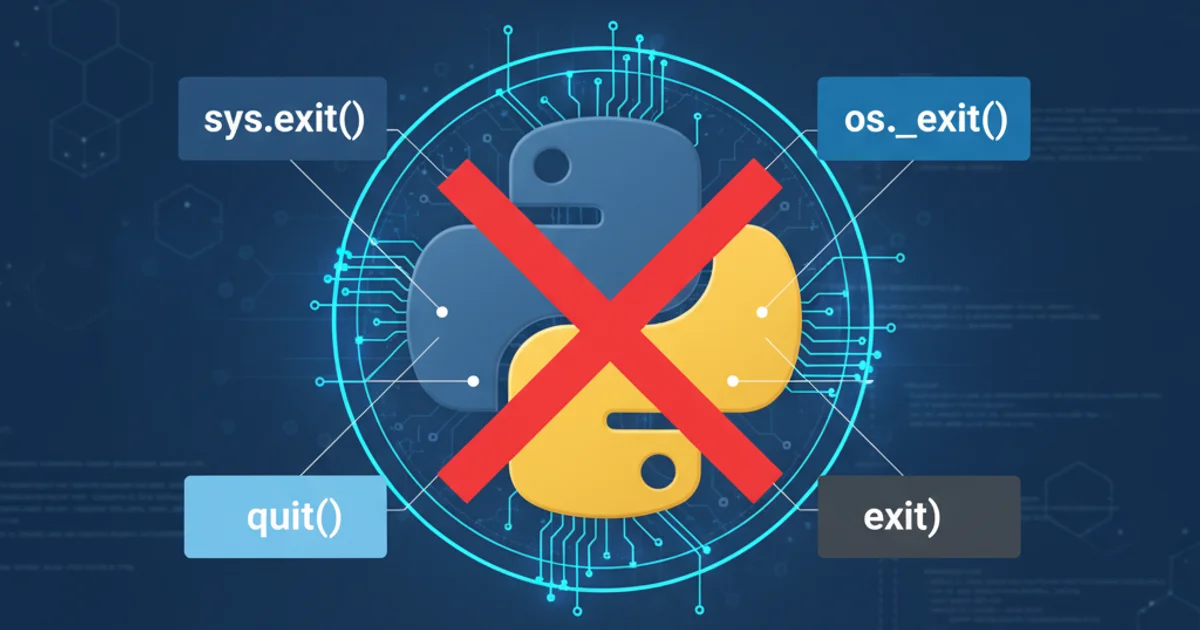Python exit commands - why so many and when should each be used?
Categories:
Python Exit Commands: Why So Many and When to Use Each

Explore the various ways to terminate a Python script, understanding the nuances of sys.exit(), os._exit(), quit(), and exit() for robust application control.
Python offers several ways to terminate a running script, each with its own purpose and implications. While they all ultimately stop execution, understanding the differences between sys.exit(), os._exit(), quit(), and exit() is crucial for writing robust, predictable, and maintainable applications. This article will demystify these commands, explain their underlying mechanisms, and guide you on when to use each one effectively.
The Standard Exit: sys.exit()
The most common and recommended way to exit a Python program is by using sys.exit(). This function raises a SystemExit exception, which can be caught by surrounding code. If unhandled, the interpreter exits, performing all necessary cleanup operations such as flushing standard I/O buffers, running finally clauses, and executing atexit registered functions. This makes sys.exit() the 'graceful' way to terminate a program.
import sys
def main():
try:
print("Starting program...")
# Simulate an error condition
if True:
print("Exiting gracefully with sys.exit(1)")
sys.exit(1) # Exit with a non-zero status code indicating an error
print("This line will not be executed.")
except SystemExit as e:
print(f"Caught SystemExit exception with code: {e.code}")
except Exception as e:
print(f"Caught other exception: {e}")
finally:
print("Finally block executed, performing cleanup.")
if __name__ == "__main__":
main()
print("Program finished (if SystemExit was caught).")
Demonstrates sys.exit() raising SystemExit and allowing cleanup.
sys.exit() for normal program termination, especially when exiting due to an error. It allows for proper cleanup and gives calling code a chance to react to the exit.The Abrupt Exit: os._exit()
In contrast to sys.exit(), os._exit() performs an immediate, unconditional exit from the process. It does not call cleanup handlers, flush stdio buffers, or execute finally clauses. This function is typically used in child processes after a fork() call, where the parent process is responsible for cleanup, or in situations where a rapid, ungraceful termination is absolutely necessary, such as handling critical, unrecoverable errors that could lead to deadlocks or corruption if cleanup were attempted. Using os._exit() in a main application thread is generally discouraged.
import os
import sys
def main():
print("Starting program...")
try:
print("Attempting to exit abruptly with os._exit(1)")
os._exit(1) # Exit immediately
except Exception as e:
# This block will NOT be reached because os._exit() doesn't raise an exception
print(f"Caught exception: {e}")
finally:
# This block will NOT be executed
print("Finally block executed.")
if __name__ == "__main__":
main()
print("This line will never be reached if os._exit() is called.")
Illustrates os._exit() bypassing cleanup and exception handling.
os._exit() with extreme caution. It bypasses all normal Python shutdown procedures, which can lead to resource leaks, corrupted files, or other undesirable side effects if not used in very specific, controlled scenarios (e.g., after fork() in a child process).Interactive Shell Exits: quit() and exit()
The functions quit() and exit() are primarily convenience functions intended for use in the interactive Python interpreter. They are not meant for use in production scripts. Both are aliases for sys.exit() and are added to the built-in namespace when the interpreter starts. If you try to use them in a script, you'll find they are not defined unless site.py (which defines them) is loaded, or you explicitly import sys and call sys.exit().
# In an interactive Python shell:
>>> quit()
# Or
>>> exit()
# In a script, without importing sys:
# This will raise a NameError
# quit()
# To make it work in a script (but still not recommended):
import sys
# sys.exit() is the proper way
sys.exit("Exiting from script using sys.exit")
Demonstrates quit()/exit() in interactive mode vs. scripts.
flowchart TD
A[Program Start]
B{Exit Condition Met?}
C[Call sys.exit()]
D[Call os._exit()]
E[Call quit()/exit()]
F[SystemExit Exception]
G[Cleanup Handlers (finally, atexit, stdio flush)]
H[Immediate Process Termination]
I[Interactive Shell Only]
J[Program End]
A --> B
B -->|Yes| C
B -->|Critical Error| D
B -->|Interactive Use| E
C --> F
F --> G
G --> J
D --> H
H --> J
E --> I
I --> F
F --> G
G --> JDecision flow for Python exit commands.